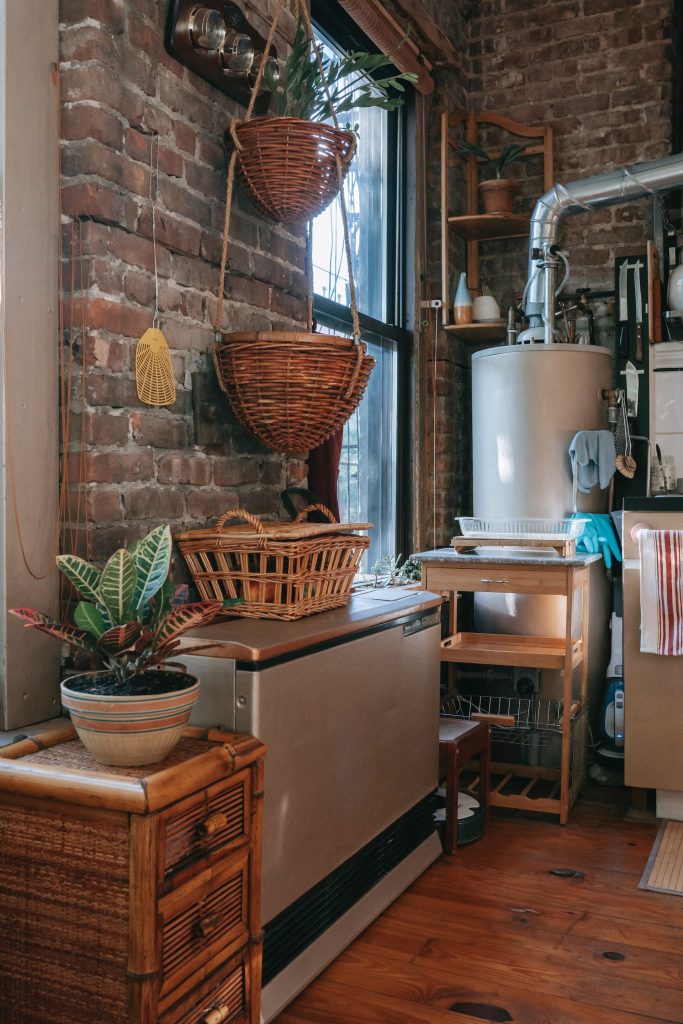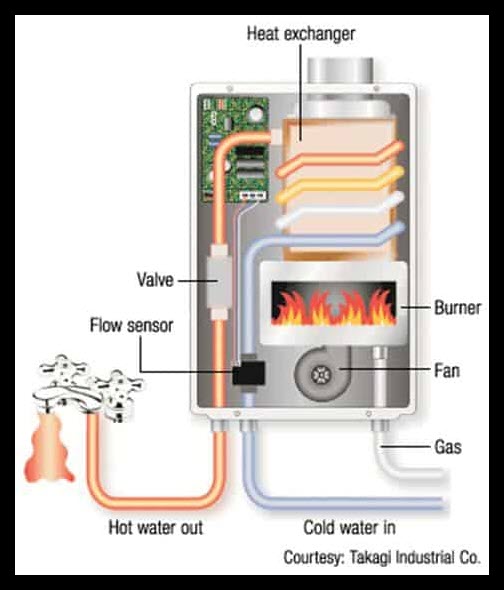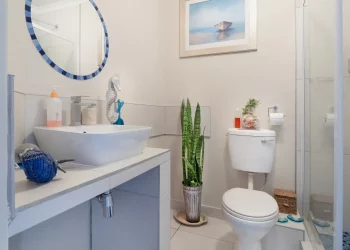Water heaters are essential appliances in modern homes, providing a steady hot water supply for various household purposes. In this article, we will explore the two basic types of water heaters: tank type and tankless, discuss their parts and functions, and how they work.
Table of Contents
ToggleTank-Type Gas Water Heater

This water heater variant is the most familiar and widely used in households.
Historically, these heaters were energy inefficient, but recent developments in self-condensing and power direct vent tank-type water heaters by American/A.O. Smith have increased efficiency levels to 95%.
Below is a cross-sectional diagram illustrating the standard components found in most tank-type heaters.

- Flue Pipe: This component expels the deadly gases containing carbon monoxide created during combustion.
- Cold Water Shut-Off Valve: This valve shuts down the cold water supply when a heater needs to be drained or replaced.
- Draft Diverter: A fitting that gathers gases to be safely evacuated into the flue and then to the outside.
- Temperature and Pressure Relief Valve (T&P Valve): This safety valve releases excess heat or pressure from a hot water tank, preventing explosions.
- Overflow Pipe: Attached to the T&P valve, it allows water to drain safely away from the heater in case of valve discharge.
- Hot Water Outlet: The pipe that enables hot water to exit the heater and enter the potable water supply.
- Anticorrosion Anode Rod (Sacrificial Anode): An essential part of a tank-type water heater, the anode rod corrodes before the exposed metal in the tank, protecting it from damage.
- Dip Tube: A tube connected to the cold water inlet that extends to the bottom of the tank, enabling cold water to enter and be heated.
- Elements: Only present in electric water heaters, elements transfer heat to the water.
- Insulation: Insulation wraps the metal tank to minimize heat loss.
- Drain Valve: This valve allows the tank to be drained.
- Thermostat or Control Valve: A mechanism to control the water temperature in the heater.
- Burner: The component that ignites natural gas or propane and heats the tank, which heats the water.
Thermocouple: A device that monitors the pilot flame and shuts off the gas flow if the flame goes out.
- Gas Supply Valve: A valve that shuts off the gas to the water heater.
Tankless Water Heaters

The need hot water is a daily necessity in households across the world.
Traditional storage tank water heaters have been a popular choice for years, but a more efficient alternative has emerged: tankless or instantaneous water heaters.
These modern devices provide hot water on demand, saving energy and ensuring you always have hot water when needed.
How Tankless Water Heaters Work
Unlike conventional storage tank water heaters, tankless water heaters do not store water in a tank for later use. Instead, they heat water instantly as it flows through the unit.
When a hot water tap is turned on, the tankless heater activates and provides the necessary hot water. This on-demand system ensures that you never run out of hot water.
Energy Efficiency
One of the main advantages of tankless water heaters is their energy efficiency.
Traditional storage tank heaters continually heat water throughout the day, even when it’s not needed, leading to heat loss from the tank.
On the other hand, tankless heaters only heat water when required, eliminating heat loss and conserving energy.
Many tankless heaters operate at around 80% efficiency, while newer models have reached up to 92% efficiency. Self-condensing units can achieve an impressive 98% efficiency.
Components of a Tankless Water Heater

At first glance, the interior of a tankless water heater may appear more like a desktop computer than a water heating device.
Several key components make up a tankless water heater, including:
- Heat exchanger: This is the primary component responsible for heating the water as it flows through the unit.
- Gas burner or electric element: These provide the heat source for the heat exchanger.
- Temperature sensors: Monitor the water temperature and adjust the heating process accordingly.
- Flow sensor: Detects when a hot water tap is opened, triggering the heater to turn on.
- Control board: Manages the various components and ensures optimal performance.
Choosing the Right Installer
When selecting a plumbing professional to install a tankless water heater, finding someone with experience and knowledge is crucial.
The installation process can be complex, involving different types of flue piping, such as stainless steel or PVC, in self-condensing units.
Additionally, ensuring that the tankless water heater you choose is the right size for your family’s needs is important.
Home centers may advertise models with a capacity of 5.6 gallons per minute (GPM), but you should consider factors like your location and incoming water temperature before deciding.
Key Considerations for Installing Tankless Water Heaters
How many bathrooms are in your current home?
How many pre-teens/teenagers live in your home?
Teenagers tend to take long showers. If you have two children aged 10 to 18 who take showers at similar times, a 5.6 GPM unit might not be sufficient. If your showerheads use 2.5 GPM and run simultaneously with an incoming water temperature of 65 degrees, you’ve already exceeded the heater’s capacity. You haven’t even turned on a kitchen sink or clothes washer and are out of hot water.
What kind of efficiency do you want, and what brand of heater is the plumbing professional trying to sell you?
Not all tankless heaters are created equal. Just because a brand is advertised more doesn’t mean it’s the best.
How is your existing tank-type heater installed in your basement?
Is it on an exterior wall or in the middle of the basement near the stairs?
This is important due to venting issues.
How will the new heater be vented?
What size and material will the flue piping be?
If a potential installer doesn’t mention changing the flue piping, politely show them the door. Due to the high exhaust temperatures, most tankless water heaters require stainless steel flue piping.
If an installer plans to use the existing flue, which is likely sheet metal, they already demonstrate a lack of knowledge.
Self-condensing units can use PVC plastic because their exhaust temperature is much cooler.
What size gas line will the unit use?
Most tankless heaters use ¾” supply piping; if you want to go with a larger tankless unit, it might need 1″. Your house may only have a ½” gas supply; you cannot get undersize the gas line. Doing so will starve the unit and ultimately result in it needing removal.
This is a challenging but fair question nonetheless: when can you realistically expect a return on your investment?
A reasonable answer is 3 to 5 years, depending on your water usage.
Understanding the basics of water heaters, their parts, and how they function is essential for homeowners and businesses.
Whether you have a traditional tank-type water heater or are considering upgrading to a more energy-efficient tankless model, being informed will help you make the best decision for your needs.
Frequently Asked Questions
What is the main difference between a tank type and a tankless water heater?
A tank-type water heater stores and heats a large amount of water in a tank, while a tankless water heater heats water on demand without storing it.
What is the typical lifespan of a water heater?
A tank-type water heater typically lasts 8 to 12 years, while a tankless water heater can last up to 20 years with proper maintenance.
Can I switch from a tank-type water heater to a tankless water heater?
Yes, but you may need to adjust your home’s plumbing, gas lines, and venting to accommodate the new system.
What is the most energy-efficient type of water heater?
Tankless water heaters are generally more energy-efficient than tank-type heaters, with some models reaching up to 98% efficiency.
How do I know what size water heater I need for my home?
The water heater size depends on your household’s hot water usage, the number of bathrooms, and any high-demand appliances like washing machines or dishwashers. Consult a professional plumber for personalized advice on choosing the right size for your needs.
Final Thoughts
Remember that a water heater should be installed by a skilled professional knowledgeable about the different types of heaters, their parts, and their installation requirements. Proper installation and maintenance will ensure that your water heater operates efficiently and safely for many years.




















